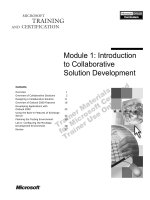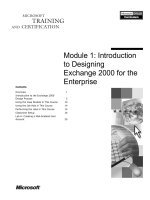Slide môn học PHP session 1 introduction to PHP
Bạn đang xem bản rút gọn của tài liệu. Xem và tải ngay bản đầy đủ của tài liệu tại đây (288.11 KB, 19 trang )
Introduction to PHP
Session 1
Objectives
Discuss the history of PHP
Identify the need for PHP
List the PHP tools
Write a simple PHP script
Use PHP to generate HTTP headers
PHP / Session 1 / Slide 2 of 19
History of PHP - I
An advance product of PHP/FI
PHP/FI stands for Personal Home Page/Forms
Interpreter
Rasmus Lerdorf created PHP/FI in the year 1995
PHP/FI got advanced to PHP/FI 2.0 in the year 1997
Andi Gutmans and Zeev Surakshi advanced PHP/FI
2.0 to PHP 3.0 in the year 1997. This was the first
version of recent PHP
PHP / Session 1 / Slide 3 of 19
History of PHP - II
PHP 3.0 provides a concrete infrastructure for
different databases, protocols, and APIs to the end
users along with the support for object oriented syntax
PHP 3.0 got advanced to PHP 4.0 in the year 1998
PHP 4.0 includes supportive features for more Web
servers, HTTP sessions, output buffering, and security
while handling user inputs
This is the latest version of PHP
PHP / Session 1 / Slide 4 of 19
Need for PHP
Uses in server-side scripting. It is platform independent
Advantages of using PHP are:
Easy to learn, use, and implement
Free for access
Executes on any platform
Executes scripts from the command line and develops
client-side GUI applications that can operate on any
platform
Uses of PHP are application control, database access, file
access, and graphics
PHP / Session 1 / Slide 5 of 19
PHP tools and setup - I
Uses for developing and designing a web pages
Contains all the supporting features for the fast developments of
the web sites. These tools are basically the programming text
editors
The tools are:
PHPEd – Helps a developer in developing applications by
supporting PHP scripts and its syntaxes. It is freely available
to the users. It is available with version 3.3
PHPDebugger DBG – Helps the PHP scripts to get executed
in steps. It helps to trace out the errors in scripts. This tool is
freely available to the users. Its current version is 2.11.23
PHP / Session 1 / Slide 6 of 19
PHP tools and setup - II
ionCube Standalone PHP Encoder – Helps in speeding up
the execution of the scripts. It is freely available. Its
updated version is 3.1. The main functionality of this tool
is that it does not allow the document to get corrupted
Codelock – Works with the PHP scripts. It is freely
available with 2.0 versions
PHing – Performs various file system operations while
processing a file. The working of this tool depends on the
platform where the PHP is working. It is freely available
for users. Its updated version is 1.0rc2
PHP / Session 1 / Slide 7 of 19
PHP tools and setup - III
NuSphere PHPEd – Uses 3.1.2 version. It is freely
available for the users. It is an Integrated Development
Environment that includes all functionalities for
developing dynamic web sites
xored:WebStudio – Uses the updated version of the tool.
Its latest version is 0.2.2. It works with the free availability
for the users. This tool is built on eclipse platform. An
eclipse platform is a tool platform for open source IDE
PHPmole – Uses GNOME platform for working with PHP.
Its latest version is 1.3 that is freely available to the users.
This tool is a combination of Dreamweaver software with
Microsoft Visual studio software
PHP / Session 1 / Slide 8 of 19
PHP tools and setup - IV
Simplewire PHP SMS Software Development kit – Works
with the wireless messaging network to send SMS to
mobile phones . It is freely available in 2.3.0 version
Quanta Plus Web Development Environment – Uses 2.0
version of tool. It is freely available to the users. It is a
web development tool
K PHP Develop – Supports MySQL as a database server.
It is freely available with 0.1.6 version of the software. It
has different modules such as server, server setup, clients
and plugins
Gedit – Uses for writing PHP scripts. It gets installed by
default while installing Linux. It is just like a notepad of
windows
PHP / Session 1 / Slide 9 of 19
Writing a Simple PHP script
Starts with <?php tag and ends with the ?> tag
Scripts are embedded in the BODY tag of the HTML
file
Saves with an extension, .php under the
/var/www/html directory
For example, display a simple text in the browser
PHP / Session 1 / Slide 10 of 19
Example for Simple PHP Script
Enter the PHP codes in gedit text editor
<HTML>
<BODY>
echo “Hello Everybody”;
?>
</BODY>
</HTML>
PHP / Session 1 / Slide 11 of 19
Output of the PHP Script
Enter http://localhost/stringdisp.php in
the address bar. The output appears, as shown in the
figure
PHP / Session 1 / Slide 12 of 19
Using PHP to generate HTTP
headers
HTTP is HyperText Transfer Protocol
It is a network transmission protocol
Uses with the help of TCP/IP protocol
Divides into three parts namely, request and response
line, HTTP header, and the body of the protocol
PHP / Session 1 / Slide 13 of 19
About HTTP header
Sends information to the client or the server about
the application that will be displayed on the
browser
Informs about the application is on request line or
on the response line
Divides into three different categories like general,
entity, and request/response
Generates the HTTP headers using the
header() function
PHP / Session 1 / Slide 14 of 19
Using header() function
Passes the HTTP commands to the server through
the HTTP protocols using the header()
function
Syntax for using the simple header() function is:
void header (‘string string’)
Where,
string - Includes authenticating or validating strings
for the server. The whole string is enclosed in the single
quotes
PHP / Session 1 / Slide 15 of 19
Example using header() function
For example, use an authenticating string in the
header() function
header(‘WWW-Authenticate:
Negotiate’);
?>
PHP / Session 1 / Slide 16 of 19
Using options of header()
function
The syntax for using header()
http_response_code option is:
function
with
void header (http_response_code)
Where,
http_response_code - Shows the response of the web
server on any request. It shows the response like status or the
location of the client
PHP / Session 1 / Slide 17 of 19
Example using the option
For example, show the location of the client
header(“Location: ”);
exit;
?>
PHP / Session 1 / Slide 18 of 19
Summary
PHP is a general purpose scripting language used for
developing dynamic web pages and embedded in HTML tags
PHP is developed from C-modules, therefore the scripts are
also executed from the command line to make client-side GUI
applications
PHP is also used for generating files in various formats like
PDF and HTML formats
PHP script starts with <?php tag and ends up only with the ?>
tag. These scripts are embedded in the HTML tags
PHP uses tools such as text editors for developing and
designing web pages. Gedit is the most popular text editor
used for programming on Linux platform
PHP / Session 1 / Slide 19 of 19









